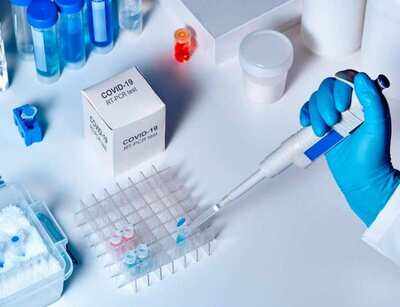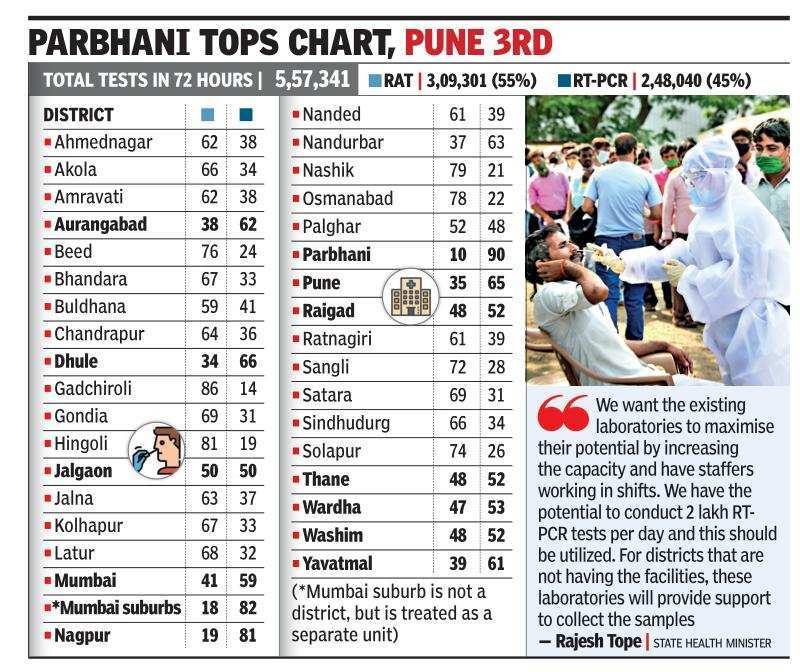Only 13 districts in Maharashtra register more RT-PCR tests than RAT

Representative image
PUNE: Only 13 of the 35 districts in Maharashtra have registered more RT-PCR tests than RAT checks in the past three days.

The state government had on June 25 ruled that the weekly positivity rates for its district-wise multi-level unlock plan would be calculated only on the basis of the RT-PCR reports and not on the Rapid Antigen Tests (RAT) for imposing restrictions in administrative units, irrespective of the weekly positivity rates and oxygen bed occupancy percentage.
Previously, the state’s multi-level unlock plan had looked at the positivity rate of both RT-PCR and RAT. The government made the change in the policy amid fears of the Delta-plus variant of Covid-19 emerging in the state.
Maharashtra has around 235 RT-PCR laboratories and almost an equal number of RAT laboratories. Until last week, RAT constituted 60% of the Covid tests and the remaining 40% were the RT-PCR tests. Once the new order was issued, the RAT percentage dropped to 55 and RT-PCR tests went up to 45% .
Though big cities such as Pune, Mumbai, Aurangabad, Nagpur, Thane and Raigad have more RT-PCR tests, many districts were still banking on RAT due to lack of necessary facilities.
Health minister Rajesh Tope on Tuesday directed health officials to assess the testing infrastructure in all districts and ramp up laboratory facilities. He said the government has directed the laboratories to increase testing shifts and focus more on RT-PCR.
“We want the existing laboratories to maximise their potential by increasing the capacity and have staffers working in shifts. We have the potential to conduct 2 lakh RT-PCR tests per day and this should be utilized. For districts that are not having the facilities, these laboratories will provide support to collect the samples,” Tope told TOI.
Three days after the orders were issued, Parbhani is the only district in the state to conduct up to 90% of RT-PCR tests, followed closely by Mumbai suburban (82%) and Pune (65%).
Districts such as Gadchiroli continued with RAT (86%). Similar was the trend in Hingoli (81%). In western Maharashtr, Sangli, Satara, Kolhapur and Solapur districts have registered nearly 70% RAT checks.
A senior health official said the districts had been given necessary instructions and the laboratories were working accordingly. “There are some genuine issues, mostly related to infrastructure and manpower, at some places. These issues will be separately addressed. The time taken to collect the swab samples and furnish the final reports has to be within a specific time frame. The weekly positivity reports will be assessed on the basis of these reports,” an official said.
Apart from the change in the weekly positivity rate calculation, the state government has added stricter restrictions by doing away with the first two levels of its unlock plan that allowed several relaxations such as opening up of malls. Now, Level 3 is the base, resulting in districts that were eligible for Level 1 and 2 restrictions slipping to Level 3. As per the revised formula, any change in status can occur only after a two-week’s “declining trend” as against one week previously.
The official added that if the districts continued to depend on RAT, the outcome would not be assessed in the weekly positivity rate even if the percentage of the test was higher, stated health officials. The official said with lower RT-PCR tests, the positivity rate would increase and the districts would move to the levels of higher curbs.

The state government had on June 25 ruled that the weekly positivity rates for its district-wise multi-level unlock plan would be calculated only on the basis of the RT-PCR reports and not on the Rapid Antigen Tests (RAT) for imposing restrictions in administrative units, irrespective of the weekly positivity rates and oxygen bed occupancy percentage.
Previously, the state’s multi-level unlock plan had looked at the positivity rate of both RT-PCR and RAT. The government made the change in the policy amid fears of the Delta-plus variant of Covid-19 emerging in the state.
Maharashtra has around 235 RT-PCR laboratories and almost an equal number of RAT laboratories. Until last week, RAT constituted 60% of the Covid tests and the remaining 40% were the RT-PCR tests. Once the new order was issued, the RAT percentage dropped to 55 and RT-PCR tests went up to 45% .
Though big cities such as Pune, Mumbai, Aurangabad, Nagpur, Thane and Raigad have more RT-PCR tests, many districts were still banking on RAT due to lack of necessary facilities.
Health minister Rajesh Tope on Tuesday directed health officials to assess the testing infrastructure in all districts and ramp up laboratory facilities. He said the government has directed the laboratories to increase testing shifts and focus more on RT-PCR.
“We want the existing laboratories to maximise their potential by increasing the capacity and have staffers working in shifts. We have the potential to conduct 2 lakh RT-PCR tests per day and this should be utilized. For districts that are not having the facilities, these laboratories will provide support to collect the samples,” Tope told TOI.
Three days after the orders were issued, Parbhani is the only district in the state to conduct up to 90% of RT-PCR tests, followed closely by Mumbai suburban (82%) and Pune (65%).
Districts such as Gadchiroli continued with RAT (86%). Similar was the trend in Hingoli (81%). In western Maharashtr, Sangli, Satara, Kolhapur and Solapur districts have registered nearly 70% RAT checks.
A senior health official said the districts had been given necessary instructions and the laboratories were working accordingly. “There are some genuine issues, mostly related to infrastructure and manpower, at some places. These issues will be separately addressed. The time taken to collect the swab samples and furnish the final reports has to be within a specific time frame. The weekly positivity reports will be assessed on the basis of these reports,” an official said.
Apart from the change in the weekly positivity rate calculation, the state government has added stricter restrictions by doing away with the first two levels of its unlock plan that allowed several relaxations such as opening up of malls. Now, Level 3 is the base, resulting in districts that were eligible for Level 1 and 2 restrictions slipping to Level 3. As per the revised formula, any change in status can occur only after a two-week’s “declining trend” as against one week previously.
The official added that if the districts continued to depend on RAT, the outcome would not be assessed in the weekly positivity rate even if the percentage of the test was higher, stated health officials. The official said with lower RT-PCR tests, the positivity rate would increase and the districts would move to the levels of higher curbs.
FacebookTwitterLinkedinEMail
Start a Conversation
end of article
Quick Links
Delhi Air PollutionDelhi TemperatureChennai WeatherBangalore TemperatureCovid vaccination centres in DelhiCoronavirus in DelhiRTPCR test in GurgaonHyderabad RainPollution level in BangaloreDelhi SmogDelhi TemperatureNoida AQIGurgaon AQI todayFire in MumbaiMumbai RainsCovid 19 RT PCR Test in NoidaDelhi AQI todaySrinagar encounter
